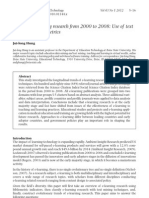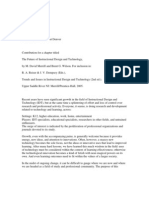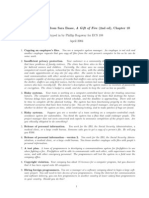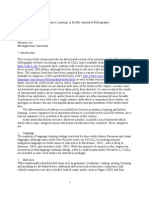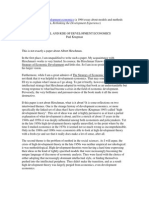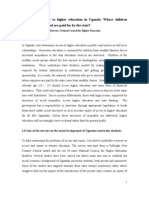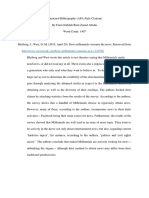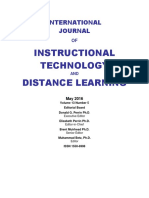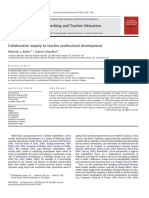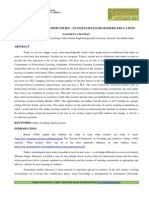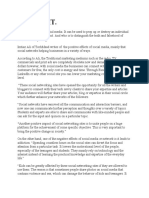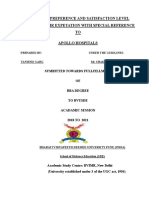Importance of Social Media in Higher Education
Uploaded by
Ayumi SatoCopyright:
Available Formats
Importance of Social Media in Higher Education
Uploaded by
Ayumi SatoOriginal Title
Copyright
Available Formats
Share this document
Did you find this document useful?
Is this content inappropriate?
Copyright:
Available Formats
Importance of Social Media in Higher Education
Uploaded by
Ayumi SatoCopyright:
Available Formats
Importance of Social Media in Higher Education - Priyanka Gupta (2015)
http://edtechreview.in/trends-insights/insights/2041-social-media-in-higher-education11
Presence of Social media is growing vigorously. But still social media is
considered to be the deteriorating agent in academics by some people. Instead of
fighting a losing battle, as social media is here to stay, the problem of web usage can be
turned into an opportunity for the good.
Social media plays an important role in every student’s life. It is easier and convenient
to access information, provide information and communicate via social media. Teachers
and students are connected to each other and can make good use of these platforms
for the working of their education.
Professors are expanding their Twitter usage to host live lectures, offer off-hours
support for students, or even host student debates. This type of social-media-meets-
office-hours path is relatively unpaved, but if teachers are to keep pace with the
changing nature of learning in the modern world, they should be open to exploring it.
Social media helps professors to be connected to their students off campus as well as
with their ex students. Professors use social media as a way of teaching by creating
groups and accounts for students where the information can be accessed. Professors
can share ideas with each other and point students to LinkedIn and Facebook.
Professors create hash tags that allow students to tag their academic posts, and view
submissions to see what the collective has creatively produced.
In this conversation with Scott Talan, an assistant professor in the School of
Communication at American University, get insights about the value of social media in
teaching.
One of the main reasons behind professors adapting to social media in classrooms is
that they can do marketing via social media. Not only they are able to make the work
easy but also are branding themselves professionally, creating a name for them in the
community. Facebook pages, twitter accounts, various blog sites and YouTube
channels are the examples where you can see professors doing excel in their stream.
These platforms are highly accessed and hence can help professors in getting the high
reputation. Who wouldn’t want that? Get known for your work while working!
In a survey by Babson survey research group and Pearson, 4,000 teaching faculty from
all disciplines in higher education, representing U.S. higher education professors,
examined both the personal and professional impacts of social media.
According to the report, key findings were:
64.4 percent of faculty use social media for their personal lives, 33.8 percent
use it for teaching.
41 percent for those under age 35 compared to 30 percent for those over age
55 reported using social media in their teaching.
Faculty in the Humanities and Arts, Professions and Applied Sciences, and the
Social Sciences use social media at higher rates than those in Natural
Sciences, Mathematics and Computer Science.
Blogs and wikis are preferred for teaching, while Facebook or LinkedIn are
used more for social and professional connections.
88 percent of faculty, regardless of discipline, reported using online video in
the classroom.
A new area of social media is increasing in popularity that is focused on building
relationships outside of the classroom.
Social Media for Community Building is the missing piece of the puzzle for Admissions
departments, Enrollment Management departments, Public Relations and Student
Services departments that are seeking to engage their audiences using social media.
In every college and university, social media is being integrated in every way possible,
including admissions, campus life, alumni relations, and in the classroom.
Leading universities like University of Southern California, Ryerson University in Toronto
and The Ohio State University have successfully integrated social media for the
betterment of their students and teachers. These three universities have their success
stories about how social media has helped their professors and learners.
People today are intimately involved with social media at every stage. If you’re missing
onto the usage of social media you are pushing away a lot of potential audience. Using
it in Higher Ed Institutions can prove to be a very effective measure.
You might also like
- IB Biology Questions - Paper 1 Topic 5 Questions89% (9)IB Biology Questions - Paper 1 Topic 5 Questions24 pages
- Transforming The Police in Central and Eastern EuropeNo ratings yetTransforming The Police in Central and Eastern Europe33 pages
- Trends of E-Learning Research From 2000 To 2008 Use of TextNo ratings yetTrends of E-Learning Research From 2000 To 2008 Use of Text12 pages
- The Future of Instructional Design and Technology100% (1)The Future of Instructional Design and Technology11 pages
- Theories of Human Communication Flashcards PDFNo ratings yetTheories of Human Communication Flashcards PDF18 pages
- Describe How Police Discretion Affects Contemporary Law EnforcementNo ratings yetDescribe How Police Discretion Affects Contemporary Law Enforcement15 pages
- Social Media For Higher Education Sept 10 VKNo ratings yetSocial Media For Higher Education Sept 10 VK54 pages
- Impact of Education On Caribbean PeopleNo ratings yetImpact of Education On Caribbean People19 pages
- Essay On Reformative Theory of PunishmentNo ratings yetEssay On Reformative Theory of Punishment3 pages
- Distance Education Bibliography AnnotatedNo ratings yetDistance Education Bibliography Annotated135 pages
- The Fall and Rise of Development EconomicsNo ratings yetThe Fall and Rise of Development Economics17 pages
- Reflective Effects of Micro-Teaching and Field Experiences On Pre-Service Teachers in NigeriaNo ratings yetReflective Effects of Micro-Teaching and Field Experiences On Pre-Service Teachers in Nigeria12 pages
- Study of Factors Affecting Online Learning Among Senior Secondary StudentsNo ratings yetStudy of Factors Affecting Online Learning Among Senior Secondary Students13 pages
- Social Media Use by Undergraduate Students of Education in Nigeria A SurveyNo ratings yetSocial Media Use by Undergraduate Students of Education in Nigeria A Survey18 pages
- UU100 Assignment Specifications - SI-2020-01 PDFNo ratings yetUU100 Assignment Specifications - SI-2020-01 PDF6 pages
- The Effectiveness of Utilizing Social Media As A Platform in The Promotion of BusinessNo ratings yetThe Effectiveness of Utilizing Social Media As A Platform in The Promotion of Business41 pages
- Reasons For Plagiarism in Higher EducationNo ratings yetReasons For Plagiarism in Higher Education13 pages
- Access and Equity To Higher Education in UgandaNo ratings yetAccess and Equity To Higher Education in Uganda20 pages
- A Study of The Effect of Teaching and Learning Science SubjectsNo ratings yetA Study of The Effect of Teaching and Learning Science Subjects9 pages
- Learning Effects of Using Learning Management System (Moodle) by Students of Arab Open UniversityNo ratings yetLearning Effects of Using Learning Management System (Moodle) by Students of Arab Open University66 pages
- IRB Project Review Form Instructions: 1 Complete This Form Using Microsoft WordNo ratings yetIRB Project Review Form Instructions: 1 Complete This Form Using Microsoft Word14 pages
- Do We Belong? A Conceptual Model For International Students' Sense of Belonging in Community CollegesNo ratings yetDo We Belong? A Conceptual Model For International Students' Sense of Belonging in Community Colleges28 pages
- Collaborative Inquiry in Teacher Professional DevelopmentNo ratings yetCollaborative Inquiry in Teacher Professional Development15 pages
- Volunteer Management Academic Essay: by Alexey Bogatov (77085913) 22.04.2011 Word Count: 2660No ratings yetVolunteer Management Academic Essay: by Alexey Bogatov (77085913) 22.04.2011 Word Count: 26609 pages
- Social Media Communication in Organizations The Challenges of Balancing Openness Strategy and ManagementNo ratings yetSocial Media Communication in Organizations The Challenges of Balancing Openness Strategy and Management23 pages
- 1.humanities ONLINE LEARNING COMMUNITIES - An Initiative For Modern EducationNo ratings yet1.humanities ONLINE LEARNING COMMUNITIES - An Initiative For Modern Education8 pages
- Why Welfare States Persist: The Importance of Public Opinion in DemocraciesFrom EverandWhy Welfare States Persist: The Importance of Public Opinion in DemocraciesNo ratings yet
- ePortfolio Performance Support Systems: Constructing, Presenting, and Assessing PortfoliosFrom EverandePortfolio Performance Support Systems: Constructing, Presenting, and Assessing PortfoliosNo ratings yet
- Effects of Social Media On Academic Performance of The StudentsNo ratings yetEffects of Social Media On Academic Performance of The Students8 pages
- How Different Countries Use Social Media in Different Ways: A New Study by The Pew Research CenterNo ratings yetHow Different Countries Use Social Media in Different Ways: A New Study by The Pew Research Center2 pages
- Positive and Negative Use of Social Media by StudentsNo ratings yetPositive and Negative Use of Social Media by Students1 page
- Emalee Schneider ENG 101 7 November 17 "Thetic" Essay Rough Draft Police BrutalityNo ratings yetEmalee Schneider ENG 101 7 November 17 "Thetic" Essay Rough Draft Police Brutality5 pages
- Mary Anne Atwood - Hermetic Philosophy and Alchemy27No ratings yetMary Anne Atwood - Hermetic Philosophy and Alchemy271 page
- Signalling Relays: Presented by P.Shakila Ios5100% (1)Signalling Relays: Presented by P.Shakila Ios5268 pages
- Cisco D9865 DVB-S - S2 Directv Receiver 4028650000000No ratings yetCisco D9865 DVB-S - S2 Directv Receiver 4028650000000260 pages
- Decadent Romanticism 1780 1914 1st Edition Kostas Boyiopoulos 2024 Scribd DownloadNo ratings yetDecadent Romanticism 1780 1914 1st Edition Kostas Boyiopoulos 2024 Scribd Download84 pages
- Jntuk 3-1 R13 Q.P May 2018 DYNAMICS OF MACHINERY PDF100% (1)Jntuk 3-1 R13 Q.P May 2018 DYNAMICS OF MACHINERY PDF2 pages
- Photo Warehouse Film Development Chart Push Processing (B/W)No ratings yetPhoto Warehouse Film Development Chart Push Processing (B/W)1 page
- Modeling and Path Simulation of An Autonomous Tomato Picking RobotNo ratings yetModeling and Path Simulation of An Autonomous Tomato Picking Robot12 pages
- MKT 304 Session 1-IMC - An IntroductionNo ratings yetMKT 304 Session 1-IMC - An Introduction35 pages
- Section 02 - The Hazards of Flood Cleanup OperationsNo ratings yetSection 02 - The Hazards of Flood Cleanup Operations22 pages
- Chapter 14: Acute Respiratory Failure Test Bank: Multiple ChoiceNo ratings yetChapter 14: Acute Respiratory Failure Test Bank: Multiple Choice13 pages
- Documenta - Sharing Best Practices 2020No ratings yetDocumenta - Sharing Best Practices 202067 pages
- 1N4099 THRU 1N4135 Silicon Zener Diode Low Noise 6.8 Volt Thru 100 Volt 250mW, 5% TOLERANCE DescriptionNo ratings yet1N4099 THRU 1N4135 Silicon Zener Diode Low Noise 6.8 Volt Thru 100 Volt 250mW, 5% TOLERANCE Description4 pages


